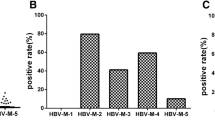Abstract
A rapid and easy method for isolating IgM from serum specimens in order to detect specific antibodies againstTreponema pallidum and rubella virus by routine serologic procedures is described. Serum IgM was isolated by immunoaffinity chromatography using anti-human IgM antibodies covalently bound to controlled-pore glass beads in a microcolumn. The final concentration of the IgM in the samples tested amounted to at least 16 % (average 32 %) of the original concentration (corresponding to a serum dilution of 1∶<8). IgG contamination did not exceed 0.38 % of the original serum concentration. The capacity of the column was stable for at least 50 absorption/ elution cycles. The new technique enables rapid and reliable detection of specific IgM by the rubella hemagglutination inhibition andTreponema pallidum hemagglutination tests.
Similar content being viewed by others
References
Vejtorp, M.: Solid-phase anti-IgM ELISA for detection of rubella specific IgM antibodies. Acta Pathologica Microbiologica Scandinavica (B) 1981, 89: 123–128.
Btaun, R., Doerr, H. W., Geisen, H. P., Hornig, C., Huschka, U., Munk, K.: Comparison of different methods for the detection of rubella-specific IgM antibodies. Journal of Medical Virology 1981, 8: 207–214.
Römer, W., Rauterberg, E. W.: Repeated affinity chromatography on glass beads with stable capacity: one-step purification of polyclonal IgA or IgM. Journal of Immunological Methods 1980, 38: 239–250.
Jungfer, H.: Immunoadsorption mit Protein-Glas-Derivaten. Ärztliches Laboratorium 1975, 21: 80–83.
Müller, F.: Serodiagnostik der Syphilis (Lues). Zentralblatt für Bakteriologie, Mikrobiologie und Hygiene (A) 1981, 250: 1–8.
Salonen, E.-M., Vaheri, A., Suni, J., Wager, O.: Rheumatoid factor in acute viral infections: interference with determination of IgM, IgG, and IgA antibodies in an enzyme immunoassay. Journal of Infectious Diseases 1980, 142: 250–255.
Vejtorp, M.: The interference of IgM rheumatoid factor in enzyme-linked immunosorbent assays of rubella IgM and IgG antibodies. Journal of Virological Methods 1980, 1: 1–9.
Geisen, H. P., Frank, R., Doerr, H. W., Enders, G.: Simple method to detect virus-specific IgM antibodies in patients' serum samples after immunosorption of immunoglobulins G and A. Medical Microbiology and Immunology 1979, 167: 77–82.
Author information
Authors and Affiliations
Rights and permissions
About this article
Cite this article
Huschka, U., Maier, J., Rauterberg, E.W. et al. Rapid separation of immunoglobulin M by immunoaffinity chromatography for detection of specific antibodies to rubella andTreponema pallidum . Eur. J, Clin. Microbiol. 1, 118–121 (1982). https://doi.org/10.1007/BF02014203
Issue Date:
DOI: https://doi.org/10.1007/BF02014203




